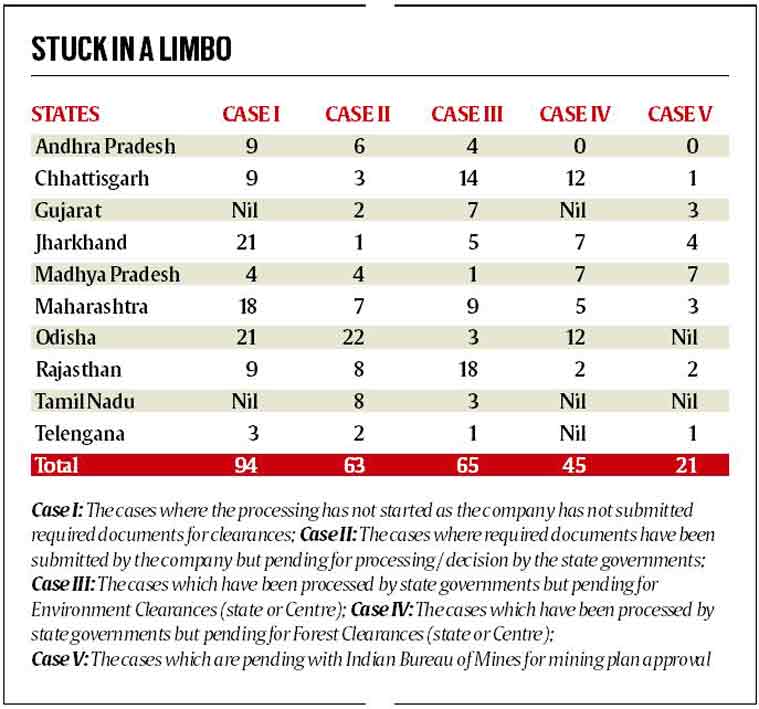Date | Aug 24, 2016:

These 288 cases are unique as the proposals were in process either with the state government or the Centre even before January 2015, when the new mining law came into effect.
With the January 11, 2017, deadline looming large, the Centre is burning midnight oil to clear 288-odd non-coal mining proposals that are stuck at various levels.
In the last few months, Union mines secretary and his state counterparts have held repeated meetings, state-level committees have been formed, letters have been sent to Union environment ministry and its state counterparts for faster clearances, Indian Bureau of Mines (IBM) has been asked to give quicker approvals to the mining plans of these proposals, even as the deadline inches closer.
These 288 cases are unique as the proposals were in process either with the state government or the Centre even before January 2015, when the new mining law came into effect. Under the old law, the firms were granted mining leases (MLs) by the states on a discretionary basis. The new law introduced a new way of granting MLs — through auction.
To avoid putting the whole sector in a limbo, the new law — Mines and Minerals (Development and Regulation) Amendment Act, 2015 — had a provision for the proposals already in process under the old law at various levels of government machinery.
While the new law stipulated that all licences henceforth would be granted only via auctions by the respective state governments, it also said that if any firm was issued a letter of intent by the state under the old law, the lease for that block should be directly granted by January 2017. Moreover, if any proposal has been approved by a state government under the earlier law but got stuck with the Centre, the lease for that too was required to be issued by January 2017.
As per the government data released on August 5, the total number of mines for which leases have to be granted by January 11, 2017 is 288. Out of these, 94 proposals are stuck because the company has not submitted the required documents with the state or central government. 110 proposals are waiting for the environment or forest clearance. 63 proposals are stuck with the mining department of respective state governments.
At present, Jharkhand’s 12 mining proposals are stuck as they pertain to the Saranda forest land where projects have been kept on hold due to lack of environmental clearances for the last few years. Chhattisgarh’s nine and Odisha’s 12 mining proposals are stuck with the Union Ministry of Environment & Forests. Gujarat’s two proposals are not moving because of the delay in clearance of its own pollution control board. Tamil Nadu’s two proposals are stuck as it is waiting for a clearance from its own environmental impact assessment authority.
Earlier, the government had released the data on May 10, which stated that a total 318 proposals are stuck. “Therefore, just a few proposals have been cleared in the last three months. Moreover, as it can be observed, even though there has been a lot of action and discussion among the Centre and states to move things forward, things have remained more or less static. The government has its task cut out. Unless it gets its act together, the companies would have to go to courts in order to get the leases,” said a sector expert on the condition of anonymity.

As part of its action plan to move things expeditiously, on June 27, the government had asked each mineral producing state to set up an internal committee to deal with this issue. This committee consists of director, State Directorate of Geology and Mining, regional controller, Indian Bureau of Mines and deputy director general, Geological Survey of India. It is not clear if the states have formed these committees or how many proposals are being handled by these committees.
Later, on August 5, in a meeting with the state officials, the Union mines ministry suggested an alternative for the applicants having trouble in obtaining stage 2 forest clearance by applying under Section 2(3) of the Forest (Conservation) Act, 1980. Under this provision, permission is given to execute the lease even in the absence of stage 2 clearance. However, work in that area can only be started after obtaining stage 2 clearance.
Even though such clearance has never been given by the Union ministry of environment & forests, the Union mines ministry was requested by the states to pursue the environment ministry to grant such permissions as the deadline is nearing.
Ultimately, it is clear that the issue pertains to not just the Union environment ministry, but the department of mines of state governments and central government, Indian Bureau of Mines, pollution control board and even National Board of Wildlife. The task is mammoth, the clock is ticking, and a consolidated action would be required to bring the results.
(Source: http://indianexpress.com/)